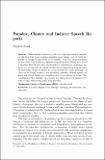Files in this item
Signification, closure and indirect speech reports
Item metadata
| dc.contributor.author | Read, Stephen | |
| dc.date.accessioned | 2016-01-11T00:12:03Z | |
| dc.date.available | 2016-01-11T00:12:03Z | |
| dc.date.issued | 2015-06 | |
| dc.identifier | 164526308 | |
| dc.identifier | 08927131-9004-4599-82e4-701a125b1e92 | |
| dc.identifier | 84932647113 | |
| dc.identifier | 000415208900007 | |
| dc.identifier.citation | Read , S 2015 , ' Signification, closure and indirect speech reports ' , Logica Universalis , vol. 9 , no. 2 , pp. 237-251 . https://doi.org/10.1007/s11787-014-0115-3 | en |
| dc.identifier.issn | 1661-8297 | |
| dc.identifier.other | ORCID: /0000-0003-2181-2609/work/62668511 | |
| dc.identifier.uri | https://hdl.handle.net/10023/7997 | |
| dc.description | Date of Acceptance: 30/09/2014 | en |
| dc.description.abstract | Bradwardine’s solution to the the logical paradoxes depends on the idea that every sentence signifies many things, and its truth depends on things’ being wholly as it signifies. This idea is underpinned by his claim that a sentence signifies everything that follows from what it signifies. But the idea that signification is closed under entailment appears too strong, just as logical omniscience is unacceptable in the logic of knowledge. What is needed is a more restricted closure principle. A clue can be found in speech act pluralism, whereby indirect speech reports are closed under intersubstitutivity of co-referential terms. The conclusion is that solving the semantic paradoxes does not require revision of logic, thus saving logic from paradox. | |
| dc.format.extent | 15 | |
| dc.format.extent | 228451 | |
| dc.language.iso | eng | |
| dc.relation.ispartof | Logica Universalis | en |
| dc.subject | Paradox | en |
| dc.subject | Signification | en |
| dc.subject | Multiple-meaning | en |
| dc.subject | Bradwardine | en |
| dc.subject | Omniscience | en |
| dc.subject | B Philosophy (General) | en |
| dc.subject.lcc | B1 | en |
| dc.title | Signification, closure and indirect speech reports | en |
| dc.type | Journal article | en |
| dc.contributor.institution | University of St Andrews. Philosophy | en |
| dc.contributor.institution | University of St Andrews. Arché Philosophical Research Centre for Logic, Language, Metaphysics and Epistemology | en |
| dc.contributor.institution | University of St Andrews. St Andrews Institute of Medieval Studies | en |
| dc.identifier.doi | https://doi.org/10.1007/s11787-014-0115-3 | |
| dc.description.status | Peer reviewed | en |
| dc.date.embargoedUntil | 2016-01-11 |
This item appears in the following Collection(s)
Items in the St Andrews Research Repository are protected by copyright, with all rights reserved, unless otherwise indicated.

